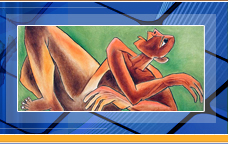DRAWING INSPIRATION 6 Oct 2002
FROM SOCIETY
G.Srinivasan
The Hindu
He is an artist waging a war against atrocities and social evils. For him, art is meant for the people, and it should be used for registering history. Pugazhendhi (35) is a painter with social consciousness.
His views about art are radical: Like poems, novels and short stories, paintings should carry a message.
He shares his views about his paintings and exhibitions he has conducted at various places with G. Srinivasan.
He is a born artist. When something disturbs his mind, he comes out with his masterpieces. Thumbathikottai Pugazhendhi’ s tryst with paintings started during his school days.
When a drawing competition was held at the Mela Ulur high school in Thanjavur district, where he studied, he jumped into the fray. Revolutionary poet Bharathiyar was the theme.
His drawing bagged the first prize. That was in the 1980s. Since then he never looked back. He joined the Kumbakonam Government College of Fine Arts and Crafts and got a Master’s in fine arts, and became a lecturer in the same college.
But it was the ethnic crisis in Sri Lanka in 1983 that crystallised him into a social artist. He brought out the sufferings of Sri Lankan Tamil people on canvass. It won him appreciation from many, increased the sympathy for the Tamils and put him on a pedestal.
He depicted the freedom struggle and followed it up with one on clashes between Tamils and Kannadigas over the Cauvery dispute in 1991.
He launched a campaign against violence and put up a canvass near the Big Temple at Thanjavur, and asked artists to paint and sign on the canvass. Little did he know that his painting on the Cauvery dispute would be relevant for long.
His duty-mindedness to reflect major happenings in a contemporary style drew him towards the caste divide in the society. Naturally, his next target was communalism.
“I was in Hyderabad for sometime. I was a witness to communal riots there. We had to live under curfew for many days. Then I decided to launch a campaign against communalism.” He recalls. Pugazhendhi’ s paintings depicted the communal clashes in gory details.
Moved by the killing of 21 Dalits by the upper caste people at Tsundur in Andhra Pradesh, he took up a campaign against casteism. He also painted the incidents of Keelavenmani in Thanjavur district, in which 44 dalits were killed.
The earthquake in Gujarat, which shattered the lives of thousands- of people, had a terrible impact on Pugazhendhi. He came out with paintings that brought out the human misery in the devastated areas and named them “Sidhaintha Kudugal”. ‘The paintings ended with the optimistic view that humanity shall overcome such disasters.
Who was his inspiration? Who else other than Pablo Picasso, a revolutionary modern painter, who migrated to France from Spain. “Picasso’s
best painting was about Spanish civil war.
His native place, Cuarnica, was bombed and Picasso came out with a painting on it. That inspired me to reflect on the happenings around the world.”
Pugazhendhi has drawn paintings on revolutionary leaders, poets and scientists such as Maxim Gorky, Mahatma Gandhi, Nethaji Subash Chandrabose, Bhagat Singh, Rabindranath Tagore, Bharathi, Einstein, Neil Armstrong and Periyar.
His pen and ink paintings of Periyar, catching his different moods, were well received all over the world.
Later they took the shape of a book, ‘Thisai Mugangal’. “Periyar is relevant even today, not only for Tamil Nadu but also for the world. I depicted 25 different feelings in my drawings. This work gave me immense satisfac-
tion,” he says.
His paintings were exhibited at various places in TamilNadu and in countries such as the U.S., France, Singapore and Malaysia.
He has won State and national awards.
“Painting transcends all barriers, and has an important role in championing a cause and moulding public opinion. Hence, it should be used for transforming the society,” notes Pugazhendhi.
|



